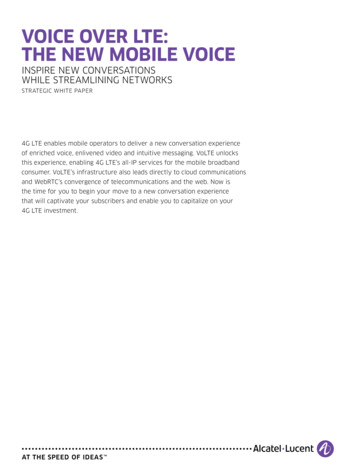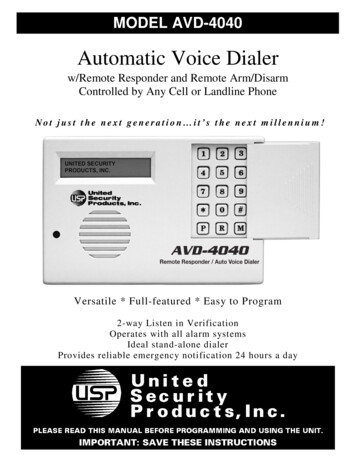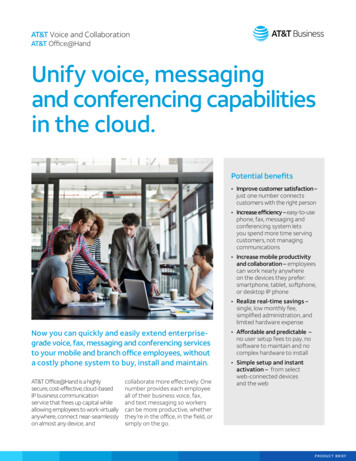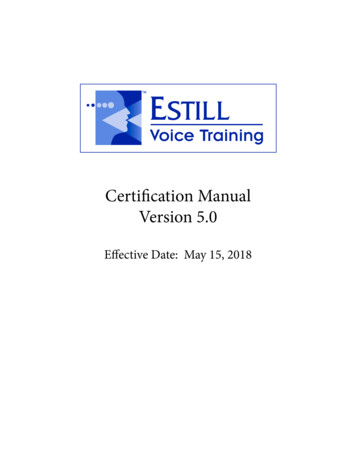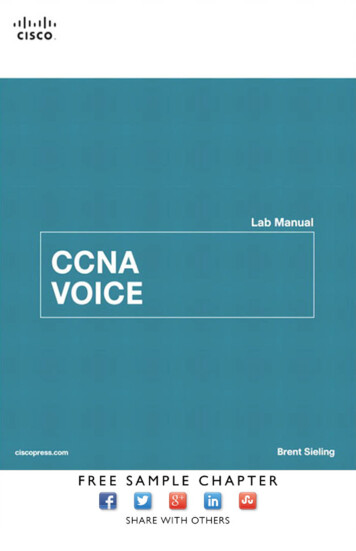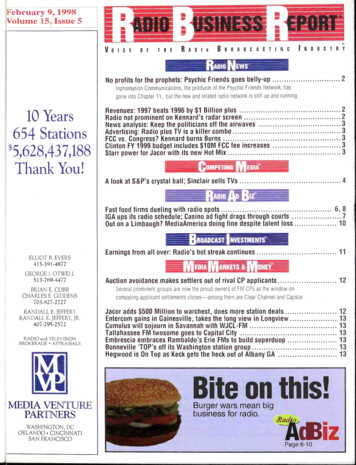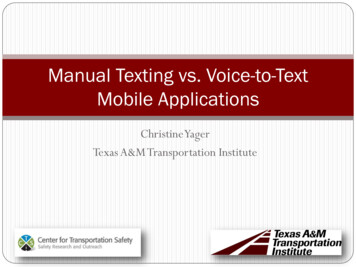
Transcription
Manual Texting vs. Voice-to-TextMobile ApplicationsChristine YagerTexas A&M Transportation Institute
Objectives Sponsored by the Southwest Region UniversityTransportation Center (SWUTC) The purpose of this research was to evaluate the impacts ofusing voice-to-text mobile applications to send and receivetext messages while driving and was driven by three primaryresearch questions:1.2.3.When texting using a voice-to-text application, does drivingimpairment improve, remain the same, or increase whencompared to manual-entry texting and the baseline?Are there any significant differences in performance betweenthe two types of voice-to-text applications that were tested?How do driver perceptions toward texting while drivingcompare to their actual performance?
Methodology 43 participants drove an instrumented vehicle on a closedcourse (23 females/20 males) Ages ranged from 16-63 Had to be very familiar with texting on a smartphone Four experimental conditions:o Baselineo Manual textingo Texting with Sirio Texting with Vlingo
Methodology
Methodology 3.8-mile long course Text messaging tasks were initiated at the same physicallocations for each conditiono Task 1: Send Onlyo Tasks 2-4: Read & Replyo Task 5: Read Only Content: Same short-phrased script for each condition
U-turnStart/EndTask 3Task 1Task 2Task 4Task 5
Methodology Performance metrics recorded:o Driver response timeso Speedo GPS (used to measure changes in lateral lane position)o Gaze trackingo Accuracy of and length of time to complete text messagingtaskso Self-performance ratings and comments
Methodology Performance metrics recorded:o Driver response timeso Speedo GPS (used to measure changes in lateral lane position)o Gaze trackingo Accuracy of and length of time to complete text messagingtaskso Self-performance ratings and comments
Methodology Performance metrics recorded:o Driver response timeso Speedo GPS (used to measure changes in lateral lane position)o Gaze trackingo Accuracy of and length of time to complete text messagingtaskso Self-performance ratings and comments
Key Findings Reaction times were nearly two times slower no matter which textingmethod was used
Key FindingsMean Response iVlingo
Key Findings Reaction times were nearly two times slower no matter which textingmethod was used The percentage of time drivers spent looking at the forward roadwaysignificantly decreased in any of the three texting conditions comparedto the baseline.
Key Findings
Key Findings Reaction times were nearly two times slower no matter which textingmethod was used The percentage of time drivers spent looking at the forward roadwaysignificantly decreased in any of the three texting conditions comparedto the baseline. Task accuracy: Siri produced fewest typographical errors compared tomanual and Vlingo Task Completion Times: Send Only: each method took approximately the same length of time Read & Reply, Read Only: manual-texting took least amount of time Self-performance Ratings: Participants rated Siri as much safer to usewhile driving than manual or Vlingo
Key FindingsAre Assisted Forms of Texting Safer than Manual Texting?Voice-to-TextMobile Apps2100500582650100Percentage of drivers who view assisted texting as less safe (left of zero) and safer (rightof zero) than manual texting.PerceptionConsiderably Less SafeSomewhat Less SafeSomewhat SaferConsiderably Safer
Key FindingsSelf-Assessment Ratings During 020PerceptionVery UnsafeUnsafe310181037010Safe2030Very Safe4050
3.8-mile long course . o Tasks 2-4: Read & Reply o Task 5: Read Only Content: Same short-phrased script for each condition . U-turn Task 2 Task 3 Task 4 Task 5 Task 1 Start/End . Methodology Performance metrics recorded: o Driver response times o Speed o GPS (used to measure changes in lateral lane position) o Gaze tracking o Accuracy of and length of time to complete text messaging
